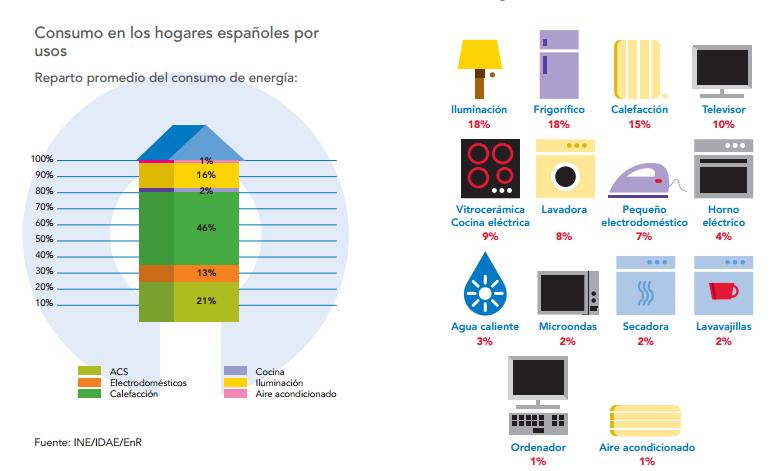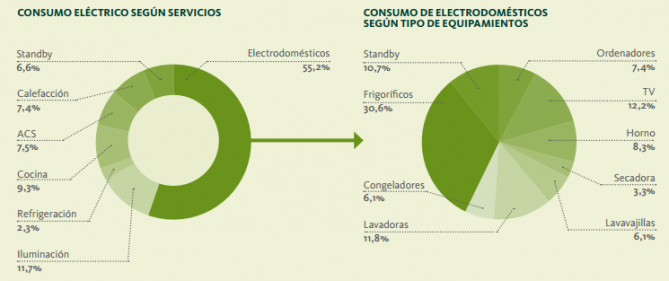-
Phone Number
-
Email Address

First we must focus on which elements of our home consumes more energy and therefore, where we carry out a greater disbursement of money at the end of the month for the expense that produces us.
If we achieve energy savings or apply a energy efficiency at home more consistent in heating, lighting and the refrigerator , we may get direct savings at the end of the month.
In the following graph we can see where we waste energy:

HEATING:
Constant temperature consumes less than turning off the heating: false. Against general opinion, keep the temperature constant during a long period of time, although not necessary, entails greater expense even if a small peak of heat is required
If the temperature is limited to 16ºC between 10 at night and 6 in the morning, you can cut around 13% in the annual fuel consumption. (Remember that the heating by pellets is the most efficient)
On the other hand, with the shutdown the savings are greater, so the new regulation in Spain advises regulating the thermostats at 20ºC in winter since for each degree of more than temperature consumes 7% more.
Apply energy efficiency; common sense for save energy and money on heating:
LIGHTING:
Keeping fluorescent lights on costs less that if they turn on and off every time: false. Studies have shown that turning on a fluorescent tube produces a peak of electrical current overconsumption that lasts only a split second. Therefore, the cost is much higher. if it is always left on.
However, the life of the fluorescent tube can be shortened with excessive fatigue paid/on. Instead, LED lamps allow turning on/off without any kind of problems and, although its price is higher, the life useful for more than 5 years and they consume 80% less. (See types energy saving light bulbs and led)
Practical example:
A traditional 100 W light bulb (which costs about 0.6 euros) provides the same light as an energy-saving lamp 20 W (about 9 euros).
If they are on for 5 hours a day, their consumption electricity throughout a year, both providing the same light, it will be:
100 W x 5 hours/day x 365 days = 182,500 Wh
20 W x 5 hours/day x 365 days = 36,500 Wh
In the electric bill we are billed by kilowatt hours (kWh). Assuming that the kWh costs 0.14 euros:
182,500 Wh x 0.14 euros/kWh = 25.6 euros
36,500 Wh x 0.14 euros/kWh = 5.11 euros
In a year the low consumption lamp saves us 20.49 euros. On the other hand, energy-saving lamps last 8 times more (8,000 hours) than light bulbs conventional (1,000 hours). The cost of both in 8,000 hours lifespan of the energy saving lamp is:
20 W x 8,000 h x 0.14 euros/kWh = 22.4 euros
100 W x 8,000 h x 0.14 euros/kWh = 112 euros
The total savings are the 90 euros saved in the electricity bill plus another 4 euros for the seven conventional light bulbs that we should have bought, since these do not usually last more than 1,000 hours. In addition, we will avoid the emission into the atmosphere of almost half ton of CO2.
FRIDGE:
Virtually all the homes have refrigerator, one of the appliances that more electricity consume at home. By having continuous use, it has a consumption very appreciable, although its power is not very great: about 200 W, in front of a hair dryer that can reach powers of 2,000 W. However, the use we make of the dryer is much lower and so is its consumption throughout of the year.
A very good article is the 10 tips for buying more efficient refrigerators. You will save, and a lot!
The main cause of cold loss in a refrigerator or freezer is due to insulation (68%). Thus, the classes more efficient have better insulation of the equipment.
Practical tips for proper efficiency energy in the fridge:
ELECTRIC STOVE:
The electric cooker uses less than the gas cooker: false. Electric stoves, more known as vitroceramics, consume 4 times more than those of conventional gas as confirmed by numerous experts. In If you have an electric stove, the IDAE recommends use cookware, pans and saucepans with a thick bottom to achieve more homogeneous temperatures throughout the container.
DISHWASHER:
Washing dishes by hand consumes less water than the dishwasher: false. A study carried out by the University of Bonn points out that the consumption of water from a class “A” dishwasher is about 15 liters while by hand about 120 liters per wash would be used.
On the other hand, reports from Canal de Isabel II and BSH Appliances Spain reflect that the use of the dishwasher, Compared to traditional washing, it leaves the dishes cleaner, saves 30 liters of water per day and consumes 10% less energy.
All this will be achieved with the use of a dishwasher efficient with low consumption certificate which, among other options, allow to choose the water temperature and reuse the heat for subsequent rinsing and drying.

The right choice of dishwasher can save you up to a 70% of energy consumption throughout its entire useful life, as well looking at our article on efficient household appliances.
Experts recommend the choice of biothermal dishwashers that admit heated water in the external boiler by means of gas instead of electricity, choose the program that best suits your needs and charge it at night , since network consumption will be less.
WINDOWS:
Heat loss through windows is minimum: false. It is considered that the heat losses through the windows are scarce since they occupy a reduced surface with respect to all the walls of the living place. Quite the contrary, without a good insulation system Losses from these surfaces can reach 25-30% of the heating used to air-condition the home.
One of the most interesting articles on the portal… What is the best window; PVC, aluminum or wood?.
Double glass or double window systems reduce almost half the heat loss with respect to the simple glazing and, in addition, reduce currents of air, the condensation of water and the formation of frost.
The type of carpentry is also decisive. Some Materials such as iron or aluminum are characterized by their high thermal conductivity, so they allow the passage of cold or heat very easily. If possible, use wooden frames for the windows.
It is worth noting the carpentry called with breakage of thermal bridge, which contain matter
Note: Standby mode is only consumes energy: false. Leaving devices on standby means an expense of 231 kWh per year, very similar to the consumption of the dishwasher (246 kWh) and that of the oven (235 kWh), and well above that of the computer (172 kWh) and that of the rest of electrical appliances (76 kWh). With all this, standby mode represents about 5% of household consumption Spanish.
From Home Repair Care